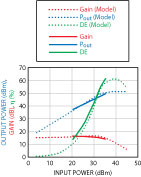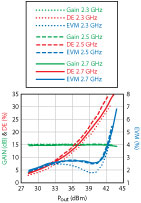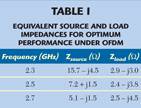The push for mobile WiMAX started in earnest with Korea’s announcement of its Wi-Bro (Wireless Broadband) a few years ago. The promise was to deliver to the user a broadband data service similar to DSL or Cable Modems but with all the benefits of mobility.
The Wi-Bro standard has been harmonized with the IEEE 802.16 standards body to become what we now call 802.16e or mobile WiMAX.1 Clearwire took the next steps in terms of mobile service provider adoption of this technology by offering a similar service as envisioned by Wi-Bro. We now see carriers with significant wireless voice businesses (Sprint & KDDI) making the decision to deploy mobile WiMAX technology in their home markets. Along the way, service providers have recognized that high quality coverage is vital to the success of this offering and the RF power amplifier is a key component to quality coverage.
The requirements for these mobile WiMAX amplifiers are among the toughest in the industry as they simultaneously push the boundaries of RF transmit bandwidth (200 MHz), average power out of the antenna (10 and 20 W at 10 dB PAR), efficiency (greater than 20 percent) and linearity (less than 2.5 percent EVM). During this same period of time, power amplifier designers are under demanding schedules as 3G networks around the world move into volume deployment. The available resource pool is very hard pressed to keep up with all the frequencies, bandwidths, power levels and linearity needs of mobile service operators around the globe.

The new NPT25100 GaN HEMT from Nitronex is a high power device based on the NRF1 platform that can be used to address multiple power amplifier scenarios including the demands of 3G and the emerging WiMAX market. The NPT25100 is ideally suited for power amplifiers covering the frequency range specified in WiMAX operations, that is, the 2.5 to 2.7 GHz frequency band, or the 2.3 to 2.5 GHz band being considered by Japanese operators, and at 2.1 GHz, where most WCDMA operators outside the US are transmitting.
NPT25100 Design and Nonlinear Simulation
The NPT25100 uses a single GaN die mounted to a thermally enhanced Cu-Mo-Cu single-ended ceramic package using an AuSi eutectic process. The GaN die used to construct the NPT25100 is a 36 mm periphery AlGaN/GaN HFET grown by MOCVD on high resistivity 100 mm silicon substrates. The physical layout of the device consists of 0.5 mm gate length, 30 mm gate pitch and a unit gate width of 200 mm. The source is grounded to the package base using vias through the 100 mm thick Si substrate. The device uses a two-stage input matching network optimized to operate over the 2.3 to 2.7 GHz frequency band and does not contain an output matching network due to GaN’s low output capacitance per watt, thus resulting in a broadband device.

The design of the NPT25100 was greatly expedited by the availability of an accurate nonlinear GaN device model. Such a model, including device impedance matching networks, and package parasitics has been modeled in both AWR’s Microwave Office (MWO) and Agilent’s Advanced Design System (ADS). The nonlinear model developed for the GaN HFET is based on the work of Angelov at Chalmers University.
The device models are openly available in both MWO and ADS and are known as “Angelov 2C” in MWO and “Angelov 2” in ADS. The model parameters were extracted on the basis of both DC and RF measurements of a 2 mm device and scaled to the required 36 mm gate width. The model accurately simulates forward gate diode conduction, self-heating, and RF performance over temperature and bias.
Figure 1 presents the modeled versus measured high power RF performance curves (output power, gain and power-added efficiency) of the NPT25100 device at 2.7 GHz demonstrating good correlation between model and measurement.
2.3 to 2.7 GHz WiMAX Performance

The NPT25100 was tested using a 802.16E OFDM compliant waveform (64 QAM 3/4, 8 burst, 3.5 MHz, 10.3 dB PAR at 0.01 percent CCDF, 75 percent full data frame, 20 ms frame length).
The device was load-pull tested at 2.3, 2.5 and 2.7 GHz at 28 and 32 V bias and 600 mA IDQ. As evident from the data shown in Figure 2, the device delivers 13 W of average RF power at 3 percent EVM with approximately 15 dB gain and greater than 25 percent drain efficiency.
The equivalent source and load impedances presented to the device are provided in Table 1.
2.14 GHz WCDMA Data in Nitronex Load-pull System
Since the NPT25100 is a broadband device, it was also tested at 2.14 GHz using a 3GPP WCDMA waveform (single carrier WCDMA, 8.5 dB PAR at 0.01 percent CCDF).
As evident from the data presented in Figure 3, the device delivers approximately 25 W of average RF power at –35 dBc ACPR with 15 dB gain and greater than 30 percent drain efficiency. Measurements were collected with a drain bias of 28 and 32 V with 600 mA IDQ.

The equivalent source and load impedances presented to the device are provided in Table 2.
Reliability of GaN on Silicon HEMTs and 2000 Hour HTOL
DC-HTOL testing was carried out at VDS of 28 V and TJ of 200°C for 2000 hours. A 45-piece sample was placed under DC-HTOL stress, with results for maximum drain current (IMAX) shown in Figure 4.
The box plots show consistent performance between the 45 samples and minimal drift with time recorded at down points of 0, 36, 168, 500, 1000, 1500 and 2000 hours. The median drift data at these down points is fit to a logarithmic relationship versus time and extrapolated forward to 20 years of operation.
The projected drift in maximum drain current at 200°C operation is less than 7 percent. Using activation energy (EA) of 2.0eV extracted from three-temperature studies predicts the drift at a more typical operating temperature of 150°C to be less than 3 percent over 20 years.

Conclusion
The design and modeling of the Nitronex NPT25100 was presented along with measured RF performance under 802.16E OFDM and 3GPP WCDMA waveforms.
The measured performance of the NPT25100 demonstrates it to be a high power, broadband, linear RF transistor, which can address the 2.3 to 2.7 GHz WiMAX and 2.14 GHz 3G BTS (base transceiver station) markets.

The broadband performance, relatively high terminal impedance, and available nonlinear transistor models in both Agilent ADS and AWR Microwave Office will benefit engineers developing power amplifiers around these transistors.
DC-HTOL reliability testing predicts that performance degradation (based on drift in Imax) over a 20-year lifetime is well within an acceptable level, making these devices ready for prime time.
Nitronex Corp.,
Durham, NC (919) 807-9100,
www.nitronex.com.
RS No.301
